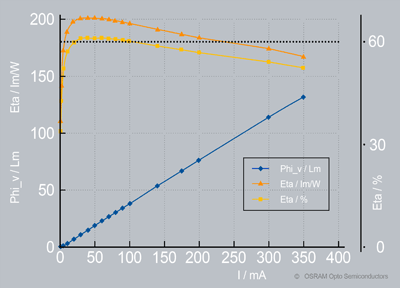Laboratory Record: Red LED Breaks Through the 200 lm/W Barrier
An LED prototype from OSRAM Opto Semiconductors achieves record efficacy
Sunnyvale, Calif., October 11, 2011 — A red high-power LED has set a new efficiency record in an OSRAM Opto Semiconductors R&D lab with an electro-optical efficiency of 61 percent. The 1 mm2 chip housed on a laboratory package emits at a wavelength of 609 nm (λ-dom) and has achieved a record value of 201 lm/W at an operating current of 40 mA. At a typical operating current of 350 mA, its luminous efficacy is still an impressive 168 lm/W, which means that even at this high wattage more than half of the electrical energy is converted into light.

World record in the OSRAM laboratory: 201 lm/W – 61% efficiency (WPE)
LED color mixing systems such as the OSRAM Brilliant Mix concept are the latest trend, particularly for general illumination applications. These systems enable any kind of white light to be produced, from Warm White through Neutral White to Daylight White. The overall performance of the system is as good as the individual components will allow. OSRAM’s new red high-power LED promises a further improvement in the quality of light with lower power consumption, especially in Warm White. This will benefit not only color mixing concepts but also all applications that use high-efficiency red LEDs in the general illumination, projection and automotive sectors.
Higher efficiency means more light from the same amount of electricity, which in turn means lower power consumption for a particular application. Because fewer chips are needed to produce the same brightness level, designers will have greater freedom. The light sources can be made smaller while still producing the same brightness.
“The results of this project can be extended to all the wavelengths in InGaAlP chip technology,” said Dr. Martin Behringer from the LED development team at OSRAM Opto Semiconductors. “We anticipate a boost in efficiency in these light colors – even at 660 nm, which is the wavelength needed for plant lighting, for example. We hope to introduce the results of this development project across the entire wavelength spectrum and into production in about a year.”
The enormous increase in output was achieved by a chip with the latest generation of OSRAM Opto Semiconductors thin-film technology.
For more information go to www.osram-os.com.
Advertisement
Learn more about Osram Opto Semiconductors





